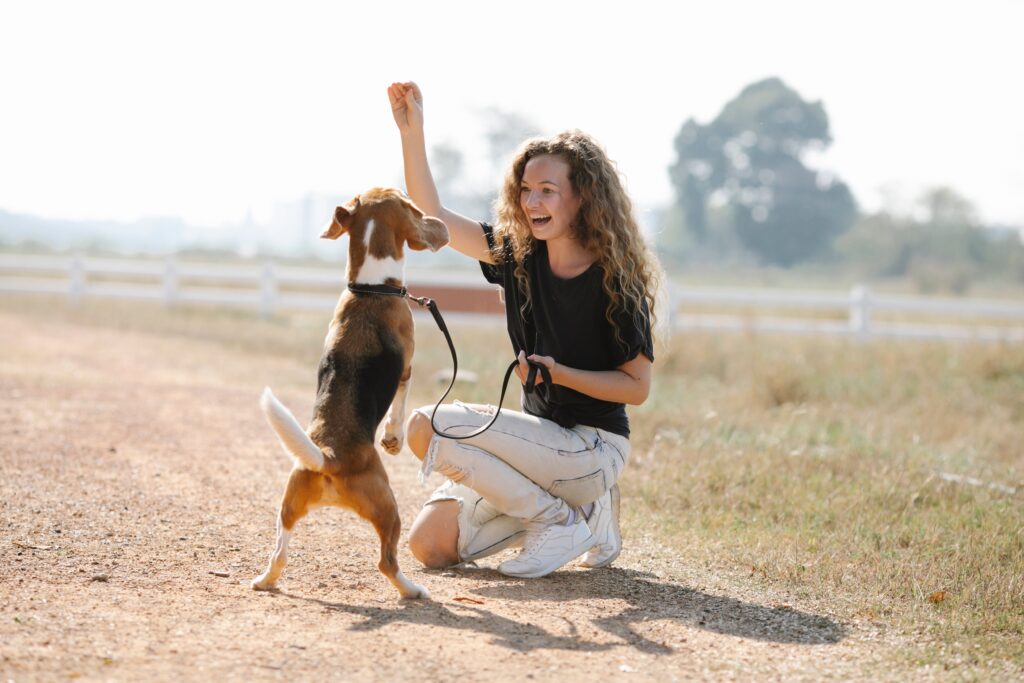Have you ever felt like your pup speaks a different language—one that’s all barks and mischief? Well, you’re not alone!
Before you shrug and think, “My dog’s a lost cause,” let’s break a myth: training isn’t just for show dogs or the super obedient. Every tail-wagger has their quirks, but training is the key to bridging the communication gap between you and your furry friend.
Picture this: You, strolling with your four-legged buddy by your side, no leash tug-of-war or embarrassing barking scenes. How? Stick around, because in this post, we’re diving nose-first into common doggy dilemmas and revealing the secrets to tail-wagging success.
From the tug-of-war champ during walks to the “alarm system” that goes off at every leaf, dog behavior can baffle even the most devoted pet parent. But fear not! We’re tackling the knots in your training journey one wag at a time.
Get ready to uncover the mysteries of leash manners, decode the language of barks, and discover practical, real-world strategies that turn training from a chore into a joyful bonding experience. Your pup’s behavior is about to get a major upgrade, and you’re in for a paw-sitively delightful ride!
The Power of Recall: Unlocking a Deeper Connection with Your Dog
Engagement: Think of recall as more than just beckoning your pup; it’s the language of trust, safety, and shared adventures. This skill isn’t about control; it’s about forging an unbreakable bond with your furry companion.
Key Points:
Everyday Situations:
Recall isn’t confined to dog parks or vast open spaces. Imagine the relief of calling your dog away from potential hazards—a busy road, a questionable snack on the sidewalk, or any other potentially dangerous scenario that may arise in daily life.
Safety Outdoors:
Picture a hike in the woods or a visit to the beach. A strong recall isn’t just a convenience; it’s a lifeline, ensuring your dog returns promptly, safe from unforeseen dangers, exploring freely while staying connected to you.
Building Trust:
At its core, recall training is about fostering trust. It’s the foundation of a relationship built on understanding and communication. When your dog comes to you willingly, it signifies not just obedience but an unspoken understanding between companions.
Setting the Stage for Success: The Crucial Preparations for Recall Training
Engagement: Before you embark on the recall training journey, let’s ensure your stage is set for success. Picture a theater; every detail, from lighting to props, matters for a stellar performance. The same applies to recall training.
Key Points:
Choosing the Right Location:
Begin training in a quiet, familiar space to minimize distractions. As your dog progresses, gradually introduce more stimulating environments, mastering recall amidst varied scenarios.
Minimizing Distractions:
Training sessions demand focus. Initiate in a distraction-free zone, gradually adding challenges. This gradual exposure builds your dog’s recall prowess without overwhelming them.
High-Value Treats:
The lure of a delectable treat can work wonders. Choose treats your dog adores and reserve them exclusively for recall training sessions, making coming back to you irresistibly rewarding.
Ensuring the Right Mindset:
Approach training with patience, positivity, and consistency. Your mindset sets the tone for your dog’s learning experience; stay upbeat and patient, celebrating every progress.
Training Techniques for Success: Crafting a Recall Superstar
Engagement: Are you ready to transform your dog into a recall pro? Let’s dive into the techniques that’ll make them dash back to you like a champion every time.
Key Points:
Recall Games:
Turn training into playtime! Engage in games like hide-and-seek or chase, reinforcing recall skills while making the experience enjoyable for your dog.
Positive Reinforcement:
Celebrate each successful return with praise and treats. This positive association ensures that coming back to you is the highlight of your dog’s day.
Gradual Progression:
Build recall gradually, starting in controlled environments and slowly introducing distractions. This step-by-step approach fosters confidence and success.
Effective Cues:
Consistency is key. Use distinct verbal or visual cues consistently, linking them to positive outcomes, reinforcing your dog’s understanding.
Patience with Setbacks:
Setbacks are part of the learning curve. Embrace them with patience and positivity, refraining from punishment, and instead, focusing on reinforcing desired behavior.
Troubleshooting and Common Mistakes: Overcoming Hurdles in Recall Training
Engagement: Even the best-laid plans encounter hiccups. Let’s navigate through common recall challenges and equip you with the tools to overcome them, transforming setbacks into stepping stones toward success.
Key Points:
Lack of Consistency:
Consistency is the backbone of training. Inconsistency confuses your dog. Ensure everyone involved in the training uses the same cues and approaches, maintaining a united front.
Distractions Galore:
Overcoming distractions takes time. Gradually expose your dog to distractions, starting with mild ones and progressively increasing intensity to reinforce their focus.
Fear or Reluctance:
Some dogs might hesitate due to fear or past negative experiences. Patience, gentleness, and positive reinforcement are crucial to build their confidence.
Practical Solutions:
Each challenge demands a tailored approach. Whether it’s revisiting foundational training or seeking professional guidance, there’s a solution for every hurdle.
The Long-Term Game: Sustaining and Strengthening Recall Skills
Engagement: Recall isn’t a one-time lesson; it’s a lifelong skill. Let’s delve into how you can maintain and enhance your dog’s recall ability, making it an ingrained behavior rather than a sporadic command.
Key Points:
Consistency Is Key:
Consistency maintains the recall’s strength. Regular practice, even after mastering the skill, reinforces the behavior, preventing regression.
Intermittent Reinforcement:
Once mastered, intermittently reinforce recall with rewards. This keeps the behavior sharp and ensures your dog remains motivated.
Keeping Sessions Fun:
Maintaining enthusiasm is crucial. Incorporate variety into training sessions, introducing new challenges to keep your dog engaged and excited about recall.
Recall in Daily Life:
Fuse recall into your daily routines. Incorporate it into games, walks, or simply calling your dog to you throughout the day, solidifying the habit.
Conclusion:
Mastering recall isn’t just about teaching your dog to come back; it’s about nurturing a relationship built on trust, safety, and mutual understanding. By understanding the nuances of recall, setting the stage for successful training, employing effective techniques, overcoming challenges, and perpetually reinforcing this vital skill, you’ll witness the transformation of your dog into a recall superstar.
Through patience, consistency, and positive reinforcement, you’re not just training a command; you’re fostering a lifelong bond founded on communication and trust—a connection that transcends the leash, making every adventure safer and every moment shared more meaningful.




